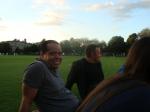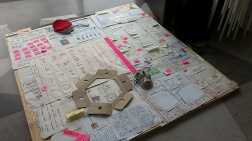The Science Gallery opened at 8am, and Gabriela decided to go in early. On the way, she took a few more photos of the area to be included in the video. Teresa Dillon had sent new feedback on the info sheet, so Corelia from home and Gabriela in the Science Gallery started doing the changes.
Gabriela sent Alan Ryan a revised timeline for the video and the additional images and had a phone conversation with him to iron out the details.
The info sheet edited by Corelia and Gabriela was then revised by Christine to make sure the language was accessible enough for the Science Gallery mediators and for the visitors. We then sent it to Teresa for a final check.
A new draft version of the video prototype arrived shortly after 1 pm. Minor changes were suggested (mainly in the text used) and Alan in Limerick started a new round of editing. The (almost) final video was received at 4pm and Gabriela brought it to the exhibition space to be tried out on the big screen. Alan made the last edits (there were 3 visualization of trails included, and we decided to keep one only), and the final copy was transferred to the computer in the exhibition at around 5pm.
Corelia and Gabriela designed a map handout for the exhibition, to encourage the public to go for a walk even if they didn’t have a smart phone. Christine produced a great-looking handout based on this initial design.
Tim Redfern continued working on the interactive map for the exhibition.
Max Kazemzadeh worked with us for most of the day to design the part of the demo that was going to run on an Android tablet in the exhibition, using App Inventor. We ran into all kind of problems – the tablet stand needed to be adjusted to the landscape format for which the map had been designed. Although the App Inventor made it easy to include Facebook, Twitter and Youtube on the menu, these options had to be removed in the end, because they were not working as planned. As we only noticed this after the tablet was locked on its stand, we had to search for the person with the key to be able to make the changes on the tablet.
Eulalia put the last touches on the documentation we had to upload to StudioLab, selecting various materials from the huge amount we collected.
Alessio installed the trails visualization on the computer that was allocated to us in the exhibition space.
As the space at the end of the first floor was going to host another event in the afternoon, everybody had to move from there to Studio 2(where we were) and Studio 1.
There was a lot of video shooting and photo taking during the day; we were video-ed at work, the coordinators were invited to record a short sequence about the project and in the end,the collaborators had to go in front of the camera as well.
At about 5:30pm everything was ready for the launch and we started packing our things and cleaning the studio. There was another event taking place upstairs, so a lot of people came through the doors. A big screen was placed on the side of our exhibition space, showing images from different phases of the Interactivos? workshop.
The launch of the exhibition was really successful – a lot of people came to talk to us! They loved the idea, some of them had suggestions, pointed out the potential problems and generally appreciated our work.
We must give a special mention to the fantastic people who work in the Science Gallery: they were always helpful and responsive, even in the maddest moments! They are a fantastic team and nothing could have happened without them!
52.674151
-8.552429


















































































